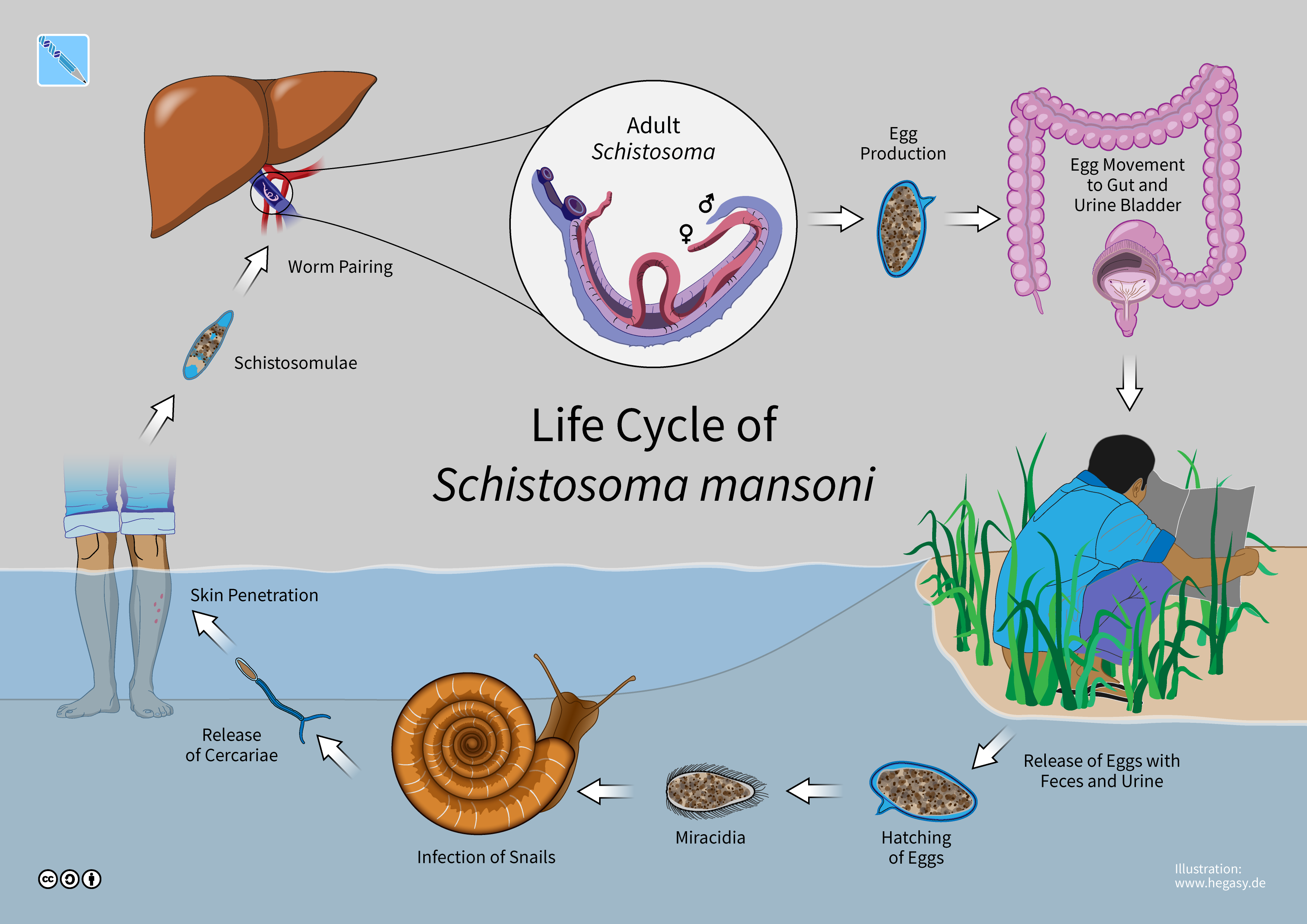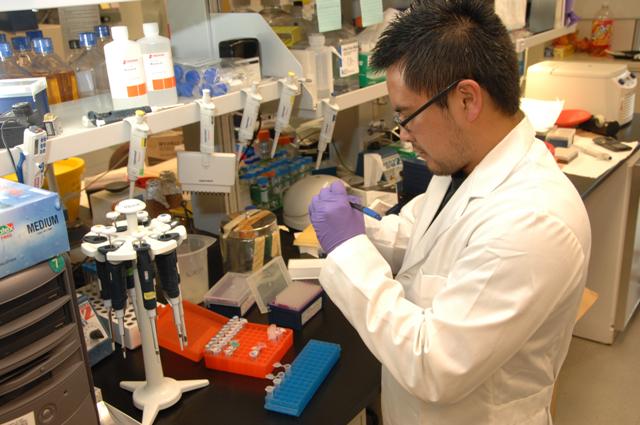|
Kato Technique
The Kato technique (also called the Kato–Katz technique) is a laboratory method for preparing human stool samples prior to searching for parasite eggs. Indications The Kato technique is now most commonly used for detecting schistosome eggs. It has in the past been used for other helminth eggs as well. It cannot be used to identify hookworm eggs because they collapse within 30 to 60 minutes of preparation using this method. One study of 299 subjects infected with ''Schistosoma mansoni'' found that the method had poor reproducibility and is therefore no longer recommended for primary health care settings: the problem may be that eggs of ''S. mansoni ''tend to clump together which means that even slides prepared from the same specimen may contain widely different egg counts. The other main argument against the Kato technique is that it is messy and therefore exposes technicians to an unnecessarily high risk of infection. Method The published methods vary in detail, but genera ... [...More Info...] [...Related Items...] OR: [Wikipedia] [Google] [Baidu] |
Human Feces
Human feces (or faeces in British English) is the solid or semisolid remains of food that could not be digested or absorbed in the small intestine of humans, but has been further broken down by bacteria in the large intestine. It also contains bacteria and a relatively small amount of metabolic waste products such as bacterially altered bilirubin, and the dead epithelial cells from the lining of the gut. It is discharged through the anus during a process called defecation. Human feces has similarities to the feces of other animals and varies significantly in appearance (i.e. size, color, texture), according to the state of the diet, digestive system and general health. Normally human feces is semisolid, with a mucus coating. Small pieces of harder, less moist feces can sometimes be seen impacted in the distal (final or lower) end. This is a normal occurrence when a prior bowel movement is incomplete, and feces is returned from the rectum to the large intestine, where wat ... [...More Info...] [...Related Items...] OR: [Wikipedia] [Google] [Baidu] |
Schistosoma
''Schistosoma'' is a genus of trematodes, commonly known as blood flukes. They are parasitic flatworms responsible for a highly significant group of infections in humans termed '' schistosomiasis'', which is considered by the World Health Organization as the second-most socioeconomically devastating parasitic disease (after malaria), with hundreds of millions infected worldwide. Adult flatworms parasitize blood capillaries of either the mesenteries or plexus of the bladder, depending on the infecting species. They are unique among trematodes and any other flatworms in that they are dioecious with distinct sexual dimorphism between male and female. Thousands of eggs are released and reach either the bladder or the intestine (according to the infecting species), and these are then excreted in urine or feces to fresh water. Larvae must then pass through an intermediate snail host, before the next larval stage of the parasite emerges that can infect a new mammalian host by directl ... [...More Info...] [...Related Items...] OR: [Wikipedia] [Google] [Baidu] |
Helminth
Parasitic worms, also known as helminths, are large macroparasites; adults can generally be seen with the naked eye. Many are intestinal worms that are soil-transmitted and infect the gastrointestinal tract. Other parasitic worms such as schistosomes reside in blood vessels. Some parasitic worms, including leeches and monogeneans, are ectoparasites thus, they are not classified as helminths, which are endoparasites. Parasitic worms live in and feed in living hosts. They receive nourishment and protection while disrupting their hosts' ability to absorb nutrients. This can cause weakness and disease in the host, and poses a global health and economic problem. Parasitic worms cannot reproduce entirely within their host's body; they have a life cycle that includes some stages that need to take place outside of the host. Helminths are able to survive in their mammalian hosts for many years due to their ability to manipulate the host's immune response by secreting immunomodulatory ... [...More Info...] [...Related Items...] OR: [Wikipedia] [Google] [Baidu] |
Hookworm
Hookworms are intestinal, blood-feeding, parasitic roundworms that cause types of infection known as helminthiases. Hookworm infection is found in many parts of the world, and is common in areas with poor access to adequate water, sanitation, and hygiene. In humans, infections are caused by two main species of roundworm, belonging to the genera ''Ancylostoma'' and '' Necator''. In other animals the main parasites are species of ''Ancylostoma''. Species The two most common types of hookworm that infect humans are ''Ancylostoma duodenale'' and ''Necator americanus''. Hookworm species that are known to infect domestic cats are ''Ancylostoma braziliense'' and ''Ancylostoma tubaeforme''. Wild cats are infected by ''Ancylostoma pluridentatum''. Dogs are commonly infected by ''Ancylostoma caninum'', but may also be infected by ''Uncinaria stenocephala'' and ''Ancylostoma braziliense''. In Asia, ''Ancylostoma ceylanicum'' is endemic among dogs and cats and infects humans. Cattle ar ... [...More Info...] [...Related Items...] OR: [Wikipedia] [Google] [Baidu] |
Schistosoma Mansoni
A paired couple of ''Schistosoma mansoni''. ''Schistosoma mansoni'' is a water-borne parasite of humans, and belongs to the group of blood flukes (''Schistosoma''). The adult lives in the blood vessels ( mesenteric veins) near the human intestine. It causes intestinal schistosomiasis (similar to '' S. japonicum'', '' S. mekongi'', ''S. guineensis'', and '' S. intercalatum''). Clinical symptoms are caused by the eggs. As the leading cause of schistosomiasis in the world, it is the most prevalent parasite in humans. It is classified as a neglected tropical disease. As of 2021, the World Health Organization reports that 236.6 million people have schistosomiasis and most of it is due to ''S. mansoni''. It is found in Africa, the Middle East, the Caribbean, Brazil, Venezuela and Suriname. Unlike other flukes (trematodes) in which sexes are not separate ( monoecious), schistosomes are unique in that adults are divided into males and females, thus, gonochoric. However, a permanent ... [...More Info...] [...Related Items...] OR: [Wikipedia] [Google] [Baidu] |
Light Microscopy
Microscopy is the technical field of using microscopes to view objects and areas of objects that cannot be seen with the naked eye (objects that are not within the resolution range of the normal eye). There are three well-known branches of microscopy: optical microscope, optical, electron microscope, electron, and scanning probe microscopy, along with the emerging field of X-ray microscopy. Optical microscopy and electron microscopy involve the diffraction, reflection (physics), reflection, or refraction of electromagnetic radiation/electron beams interacting with the Laboratory specimen, specimen, and the collection of the scattered radiation or another signal in order to create an image. This process may be carried out by wide-field irradiation of the sample (for example standard light microscopy and transmission electron microscope, transmission electron microscopy) or by scanning a fine beam over the sample (for example confocal laser scanning microscopy and scanning electro ... [...More Info...] [...Related Items...] OR: [Wikipedia] [Google] [Baidu] |
Medical Laboratory Scientist
A medical laboratory scientist (MLS) or clinical laboratory scientist (CLS) or medical technologist (MT) performs diagnostic testing of blood and body fluids in clinical laboratories. The scope of a medical laboratory scientist's work begins with the receipt of patient or client specimens and terminates with the delivery of test results to physicians and other healthcare providers. The utility of clinical diagnostic testing relies squarely on the validity of test methodology. To this end, much of the work done by medical laboratory scientists involves ensuring specimen quality, interpreting test results, data-logging, testing control products, performing calibration, maintenance, validation, and troubleshooting of instrumentation as well as performing statistical analyses to verify the accuracy and repeatability of testing. Medical laboratory scientists may also assist healthcare providers with test selection and specimen collection and are responsible for prompt verbal delivery o ... [...More Info...] [...Related Items...] OR: [Wikipedia] [Google] [Baidu] |
World Health Organization
The World Health Organization (WHO) is a specialized agency of the United Nations responsible for international public health. The WHO Constitution states its main objective as "the attainment by all peoples of the highest possible level of health". Headquartered in Geneva, Switzerland, it has six regional offices and 150 field offices worldwide. The WHO was established on 7 April 1948. The first meeting of the World Health Assembly (WHA), the agency's governing body, took place on 24 July of that year. The WHO incorporated the assets, personnel, and duties of the League of Nations' Health Organization and the , including the International Classification of Diseases (ICD). Its work began in earnest in 1951 after a significant infusion of financial and technical resources. The WHO's mandate seeks and includes: working worldwide to promote health, keeping the world safe, and serve the vulnerable. It advocates that a billion more people should have: universal health care coverag ... [...More Info...] [...Related Items...] OR: [Wikipedia] [Google] [Baidu] |
Eggs Per Gram
Eggs per gram (eggs/g) is a laboratory test that determines the number of eggs per gram of feces in patients suspected of having a parasitological infection, such as schistosomiasis. Measuring the number of eggs per gram is the primary diagnostic method for schistosomiasis, as opposed to a blood test. Eggs per gram or another analyse like larvae per gram of faeces is one of the most important experiments that is done in parasitology labs. Methods to count the number of eggs per gram: * Willis method * McMaster method * Clayton-Lane method See also * Kato technique * Helminths Parasitic worms, also known as helminths, are large macroparasites; adults can generally be seen with the naked eye. Many are intestinal worms that are soil-transmitted and infect the gastrointestinal tract. Other parasitic worms such as ... References External links * Parasitology Clinical pathology {{Pathology-stub ... [...More Info...] [...Related Items...] OR: [Wikipedia] [Google] [Baidu] |






